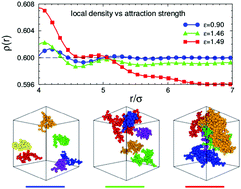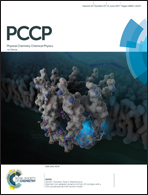Tiny changes in local order identify the cluster formation threshold in model fluids with competing interactions
Abstract
We use Monte Carlo simulations to carry out a thorough analysis of structural correlations arising in a relatively dense fluid of rigid spherical particles with prototype competing interactions (short-range attractive and long-range repulsive two-Yukawa model). As the attraction strength increases, we show that the local density of the fluid displays a tiny reversal of trend within specific ranges of interparticle distances, whereupon it decreases first and increases afterwards, passing through a local minimum. Particles involved in this trend display, accordingly, distinct behaviours: for a sufficiently weak attraction, they seem to contribute to the long-wave oscillations typically heralding the formation of patterns in such fluids; for a stronger attraction, after the reversal of the local density has occurred, they form an outer shell of neighbours stabilizing the existing aggregation seeds. Following the increment of attraction, precisely in correspondence of the local density reversal, the local peak developed in the structure factor at small wavevectors markedly rises, signalling—in agreement with recent structural criteria—the onset of a clustered state. A detailed cluster analysis of microscopic configurations fully validates this picture.



 Please wait while we load your content...
Please wait while we load your content...